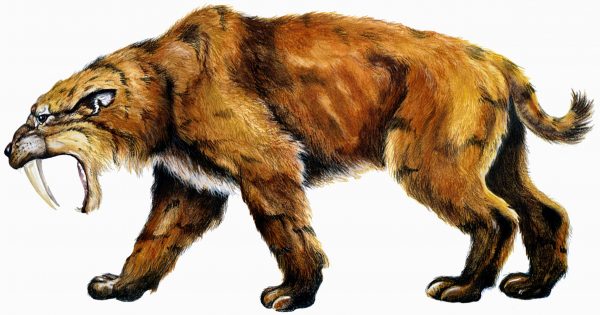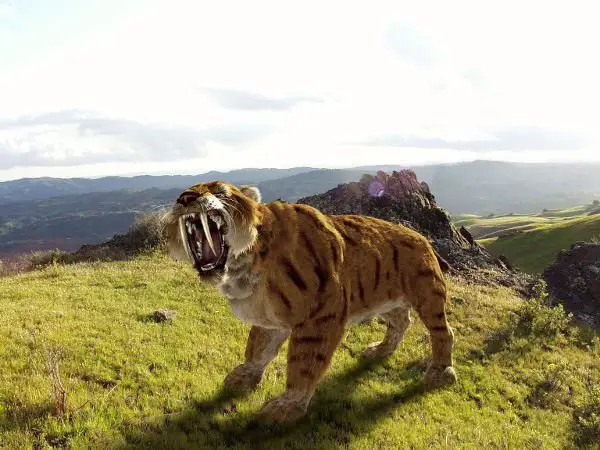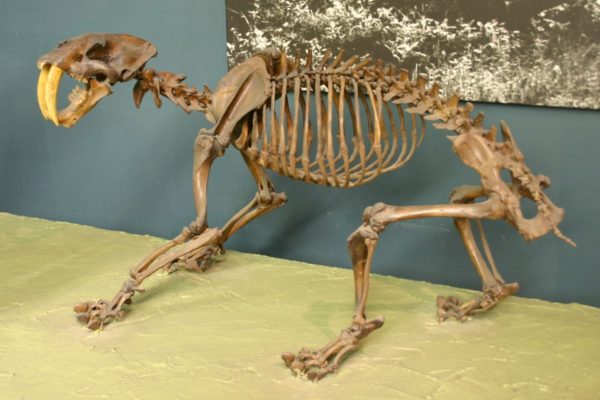Ever fascinated by prehistoric animals, kids are particularly captivated by the Saber Tooth Tiger. It’s a creature that exemplifies amazing prehistoric life. We’ve compiled key Saber Tooth Tiger Facts For Kids . You’re invited to discover their world, discovering scientific names, characteristics, classes, and appearances. Additionally, you’ll explore interesting aspects such as their habitat, and diet. Who were their prey? This, and their distinct behavioural patterns, curious adaptations, intriguing hunting techniques and much more will be unraveled.
Those with a school assignment on Saber Tooth Tigers provided by a research paper writer from SmartWritingService will find it particularly useful
Saber Tooth Tiger Facts For Kids
What is a Saber Tooth Tiger
In short, the Saber Tooth Tiger is a prehistoric carnivorous mammal, with a distinctive pair of long razor-sharp canine teeth, that went extinct at the end of the Ice Age about 10,000 years ago. It is very popular among prehistoric animals due to its fascinating looks and its elongated sword-shaped canine teeth. It was found in North and South America and existed between the Eocene and Pleistocene periods, which ranged from 55 million years to 10,000 years ago. It was the primary predator in the woodlands and grasslands.
Previous studies of fossils suggested that the Saber Tooth Tiger became extinct mainly due to the lack of food, which was caused by climate change. Climate change caused plant extinction, resulting in the extinction of herbivores (animals that eat plants), and ultimately causing the Saber Tooth Tiger’s extinction, as there were no more herbivores to hunt for food. Recent studies on fossils deny the above reason for extinction but do not provide any new theory on Saber Tooth Tiger extinction.
The Saber Tooth Tiger is also called the saber-toothed lion or saber-toothed cat, but in reality, it is not a tiger or a lion or even close to the cats that we have today. It belongs to an extinct subfamily of the cat family (Felidae) called Machairodontinae.
The Saber Tooth Tiger is also called the saber-toothed lion or saber-toothed cat but in reality, it is not a tiger or a lion or even close to the cats that we have today. It belongs to an extinct subfamily of the cat family (Felidae) which is called Machairodontinae.

Scientific Name
The scientific name for the Saber Tooth Tiger is “Smilodon,” which means tooth like a double-edged knife.
Scientific Classification
Kingdom: Animalia
Phylum: Chordata
Class: Mammalia
Order: Carnivora
Family: Felidae
Subfamily: Machairodontinae
Tribe: Smilodontini
Genus: Smilodon
Saber Tooth Tiger Description
The Saber Tooth Tiger has been named after its long and sharp canines. Its two long canines could grow up to 20 cm or 8 inches, which helped in cutting and stabbing its prey. The lower canines were smaller in size, and the molar teeth were smooth and resembled the modern-day shearing blades. Its jaw could open up to an angle of 90 degrees to use the long teeth for hunting purposes. This gape is much larger than modern cats. Its neck had strong muscles to bring down the heads of large prey. Its limbs were short but very well-developed for hunting. The fully grown Saber Tooth Tiger size was about that of a modern-day African Lion (Panthera Leo). The smallest species of saber tooth tiger, S. gracilis, found in North America, weighed 55 to 100 kg, while the largest species from South America, S. populator, weighed 220 to 400 kg. The coat color pattern of the Saber Tooth Tiger is yet unknown.

Saber Tooth Tiger Characteristics
Teeth
The most distinctive feature of the Saber Tooth Tiger is its long and sharp canines, which are almost 20 cm (8 inches) long. These teeth were used to stab and cut through the flesh of their prey. However, the Saber Tooth Tiger did not use its canines to crush bones, as they were quite fragile and could easily break during a hunt. In addition to their canines, the Saber Tooth Tiger had molars that were smooth and sharp-edged, similar to the shearing blades of modern-day carnivores.
Jaw
The Saber Tooth Tiger had a unique jaw structure that allowed it to use its long canines for hunting purposes. Its jaw could open up to an angle of 90 degrees, which was much larger than the modern cats. This wider gape allowed the Saber Tooth Tiger to use its long teeth to pierce through the neck of its prey and cause fatal injuries.
Limbs
The limbs of the Saber Tooth Tiger were short but well-developed, which made them perfectly suited for hunting. Their forelimbs were particularly strong and muscular, which allowed them to wrestle down large prey. The Saber Tooth Tiger had retractable claws, which they could use to climb trees or dig up burrows of prey.
Size
The size of the Saber Tooth Tiger varied depending on the species, with the smallest species, S. gracilis, found in North America, weighing between 55 to 100 kg (120 to 220 lbs). The largest species, S. populator, found in South America, weighed between 220 to 400 kg (485 to 880 lbs). The fully-grown Saber Tooth Tiger was about the same size as a modern-day African Lion (Panthera leo).
Speed
The running speed of the Saber Tooth Tiger is not accurately known, but it was likely slower than the modern Lion and Tiger due to its heavier build. Its top speed was estimated to be around 25 to 30 mph.
Lifespan
The average lifespan of the Saber Tooth Tiger is unknown, as no fossil evidence of a naturally-occurring aged Saber Tooth Tiger has been found. However, it is thought that their lifespan was similar to that of modern-day big cats, which ranges from 10 to 20 years.
Where did the Saber Tooth Tiger live
The Saber Tooth Tiger lived in North and South America during the Miocene and Pliocene Epoch, which was between 23 million to 2.6 million years ago. They spread to Asia and Africa after the Pliocene Epoch. Some Saber Tooth Tigers moved to South America during the Pleistocene Epoch, which was between 2.5 million to 10,000 years ago.
Saber Tooth Tiger Habitat
The Saber Tooth Tiger lived in areas where plant-eating animals lived. These areas included pine forests, shrubby areas, and grasslands. They preferred habitats where there was an abundant supply of prey animals.
Learn more about its Habitat: Saber Tooth Tiger Habitat

What Did Saber Tooth Tiger Eat?
The Saber Tooth Tiger was a carnivore and ate any meat it could find. However, it mostly hunted herbivores, such as horses, bison, and mastodons, which were extinct hairy elephants. Due to their long canines, they were able to stab and cut through the flesh of their prey, which made it easier for them to consume the meat.
Learn more: What did Saber Tooth Tigers Eat
Prey
The Saber Tooth Tiger mostly hunted herbivores, such as horses, bison, and mastodons. They were not able to chase after small animals like deer and antelope
Here is a complete list of prey: Saber Tooth Tiger Diet

Saber Tooth Tiger Facts – Species
- The Saber Tooth Tiger has three species:
1. Smilodon fatalis
2. Smilodon gracilis
3. Smilodon populator - S. gracilies was the smallest among the species, while S. populator was the largest.
- The main difference between these species was weight and size.
Saber Tooth Tiger Facts About its Size
- Different species of the Saber Tooth tigers came in different sizes.
- Following are the different species with their weights and sizes from smallest to largest:
- Specie: S. gracilis
- Weight : 55 to 100 kg
- Height: Unknown
- Specie: S. fatalis
- Weight : 160 to 280 kg
- Height : 100 cm
- Specie: S. populator
- Weight : 220 to 400 kg
- Height : 120 cm
- Specie: S. gracilis
Learn more: How big was a Saber Tooth Tiger
Saber Tooth Tiger Size Comparison
The Saber Tooth Tiger was the size of the modern African Lion (Panthera Leo) and Tiger. However, the Smilodon had a stronger build than the modern cats.
Compared to humans, the Saber Tooth Tiger had more weight but was shorter in height.

How did Saber Tooth Tigers Hunt
Saber Tooth Tigers hunted in packs like modern lions. However, the Saber Tooth Tiger had different killing techniques than modern cats. It used to wrestle large prey to the ground by using its claws and forelimbs, then ripped open its throat using the large canines to kill it instantly. It could only hunt large herbivores because it didn’t have the agility to chase small animals like deer and antelope. So, it preferred ambushing its prey.
However, the Saber Tooth Tiger’s bite force was weaker than that of modern lions, so it relied more on its canines to deliver the killing blow. The Saber Tooth Tiger was not as fast as modern cats and preferred to ambush its prey rather than chase it down.
Behavior
The Saber Tooth tiger lived and hunted in packs. This ensured that they had food even when they were ill, injured, or old. Other members of the pack used to share food with the affected member. Just like modern lions, the saber tooth tigers hunted animals in the group by trapping them. There were no visible differences in behavior and appearance between the male and female saber tooth tigers.
Inter-species Interaction
Smilodon was the top predator in its habitat. The availability of prey was equal to or greater than the prey availability today in East Africa. Near the end of the Pleistocene Epoch, Smilodon and other carnivores often broke their teeth indicating intense competition in hunting and eating the prey to their bones.
As the Smilodon couldn’t crush bone, they could have been associated with bone-crushing hyenas.
Saber Tooth Tiger Facts About Its Adaptations
The Saber Tooth Tiger had several unique adaptations that made it a formidable predator. Its long, sharp canines were ideal for slicing through the tough hide and muscle of large herbivores. The Saber Tooth Tiger also had strong neck muscles that allowed it to hold onto struggling prey. Its shorter limbs were well-suited for powerful bursts of speed and agility, making it an efficient hunter in dense forests and grasslands. Additionally, the Saber Tooth Tiger was a social animal that hunted in packs, which increased its chances of success and ensured that injured or sick members of the pack were still able to eat.
- The Saber Tooth Tiger had a bob-tail which suggests that it used to ambush its prey instead of chasing it like modern Lions and Tigers.
- It had 20 cm long canine teeth which had an oval cross-section that could be used as knives. They were useful for slicing meat but also fragile. They could easily break while hunting. They could also be used for social display as horns.
- Its killing behavior determines that its bite wasn’t as strong as a modern lion. That is why they wrestled the prey to the ground before delivering the killing bite with their sharp canines. However, it is unknown how the finishing bite was delivered.
- About social behavior, it has been discovered that the Saber Tooth Tiger was a social animal and used to hunt in packs. Fossils have shown evidence of regrowth and healing, which suggests they lived for a long time after getting injured. Other members of the pack brought food for the injured Smilodon. However, it has been discovered they were also not very peaceful. Sometimes, they fought among themselves for food or mates like modern lions.

Extinction
The Saber Tooth Tiger went extinct at the end of the Pleistocene Epoch, around 10,000 years ago. The exact cause of its extinction is still a matter of debate among scientists, but several theories have been proposed. One theory is that climate change caused the extinction of the Saber Tooth Tiger by altering the distribution of plants and animals that it relied on for food. Another theory suggests that overhunting by humans, along with habitat destruction and competition with other predators, led to the Saber Tooth Tiger’s demise. Regardless of the cause, the Saber Tooth Tiger remains one of the most fascinating and mysterious creatures of the prehistoric world.
Read more: Why did the Saber Tooth Tiger Go Extinct
Interesting Saber Tooth Tiger Facts
- When compared to Lion, the Sabertooth tiger was shorter in size and heavier in weight.
- Its length was around 79 to 98 inches and its weight was from 150 to 661 pounds.
- Sabertooth tiger has the word tiger in its name but it was not a tiger. It is not even closely related to modern-day cats such as lions, leopards, cheetah, and tigers.
- Their coat was thick and similar in color to that of a lion.
- The growth of canine teeth of saber tooth tiger was two times faster than the cats that are alive today. The fully grown canine teeth were attained at the age of three years.
- It used its canine teeth to cut the jugular vein of its prey.
- The bite force of a saber tooth tiger was three times less than that of a modern lion.
- Saber-toothed tigers used to ambush their prey instead of chasing it.
- Due to the presence of hyoid bone in their mouth, they were able to roar.
- Sabertooth tigers most probably mated in the Spring season. The pregnancy period was around 8 months.
- The cubs were born blind and helpless similar to that of modern-day cats.
- The estimated lifespan of the saber tooth tiger ranges from 20 to 40 years.
